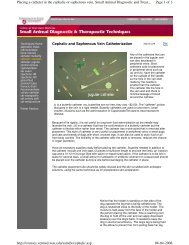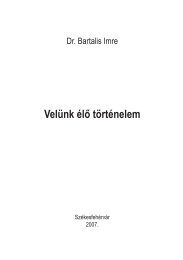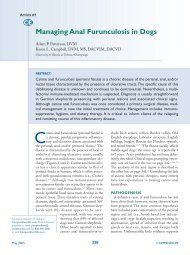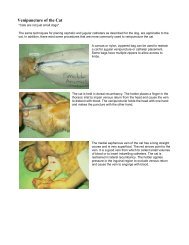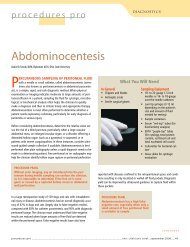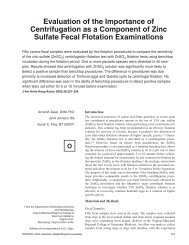Diabetic Ketoacidosis - Hungarovet
Diabetic Ketoacidosis - Hungarovet
Diabetic Ketoacidosis - Hungarovet
You also want an ePaper? Increase the reach of your titles
YUMPU automatically turns print PDFs into web optimized ePapers that Google loves.
16 Veterinary Technician January 2001 <strong>Diabetic</strong> <strong>Ketoacidosis</strong><br />
osmotic diuresis. Fluid loss may also be caused by vomiting<br />
and lack of fluid intake. Within 20 to 24 hours after<br />
initiating fluid therapy, the goal is to return the patient to<br />
a normovolemic state evidenced by normal blood pressure;<br />
normal heart rate; normal central venous pressure;<br />
balanced ins and outs; sufficient urine production; normal<br />
skin turgor; and pink, moist mucous membranes.<br />
A central venous catheter should be placed so that periodic<br />
blood samples can be easily obtained and central venous<br />
pressure measurements can be taken to help guide<br />
fluid therapy. Initially, the fluid type to be administered<br />
will be dictated by electrolyte status. Because<br />
many DKA patients also have hyponatremia,<br />
0.9% saline is often given.<br />
DKA patients typically experience potassium<br />
depletion; therefore, fluids that are administered<br />
should be potassium enriched.<br />
Fluid rates and volumes will depend on the<br />
severity of dehydration, the animal’s maintenance<br />
needs, and abnormal ongoing losses<br />
(i.e., vomiting, diarrhea, diuresis). Caution<br />
should be exercised when giving<br />
hypotonic sodium solutions because these<br />
fluids have an increased amount of free<br />
water relative to isotonic solutions. Too<br />
much free water will put the patient at risk<br />
for developing cerebral edema. When the<br />
patient’s glucose declines to 250 mg/dl or<br />
less, 50% dextrose should be added to the<br />
fluid therapy to make a final dextrose concentration<br />
of 2.5% to 5%.<br />
Normalizing Blood Glucose Levels<br />
Regular crystalline insulin is recommended<br />
for treating DKA. Insulin therapy<br />
will decrease BG levels by driving glucose<br />
into the cells, thereby providing them with<br />
an alternative energy source other than<br />
ketone-producing fatty acids (see Effects of<br />
Insulin). Insulin therapy also drives potassium<br />
into the cells and will result in<br />
decreased serum potassium levels, thus<br />
unmasking a total body potassium deficit.<br />
Insulin protocols include<br />
intermittent intramuscular<br />
(IM) and<br />
continuous low-dose<br />
intravenous (IV) infusion<br />
techniques.<br />
When using the IM<br />
technique, insulin should<br />
Insulin Overdose and Clinical Signs of Hypoglycemia<br />
■ Overt hypoglycemia<br />
Lethargy, weakness,<br />
head tilting, ataxia, seizures<br />
Effects of Insulin<br />
■ Promotes glucose uptake<br />
by target cells<br />
■ Provides for glucose<br />
storage<br />
■ Prevents fat and glycogen<br />
breakdown<br />
■ Inhibits gluconeogenesis<br />
■ Increases protein synthesis<br />
Figure 2—An example of piggybacking<br />
fluids. In the inset, a secondary<br />
(piggybacked) line is attached to the<br />
primary infusion line. (Copyright ©<br />
Harold Davis, BA, RVT, VTS [ECC];<br />
Davis, CA)<br />
■ Insulin resistance<br />
■ Insulin-induced hyperglycemia<br />
(Somogyi effect)<br />
be administered hourly; the dose should be adjusted based<br />
on the rate of declining glucose levels. Once the animal’s<br />
BG level approaches 250 mg/dl, the hourly IM insulin dose<br />
should be administered subcutaneously every 4 to 6 hours.<br />
When the patient begins eating and drinking and is no<br />
longer ketotic or vomiting, long-acting insulin may be<br />
used.<br />
In the continuous low-dose IV infusion technique, the<br />
regular insulin dose should be diluted in 250 ml of 0.9%<br />
saline solution. The insulin infusion should be piggybacked<br />
(Figure 2) onto the primary fluid line and administered<br />
with a fluid infusion pump. Because<br />
insulin binds to glass and plastic, the<br />
first 50 ml of the infusion should be discarded.<br />
Regardless of the insulin protocol used,<br />
serum glucose levels should not be allowed<br />
to drop too fast; otherwise, the patient<br />
is at risk for developing cerebral edema.<br />
Cerebral edema occurs when an<br />
osmotic gradient develops between the<br />
brain and the extravascular fluid space.<br />
In addition to insulin, fluid therapy can<br />
be used to reduce serum glucose concentration.<br />
Fluids enhance glucose excretion by<br />
increasing glomerular filtration and urine<br />
flow. Fluids also decrease the secretion of<br />
diabetogenic hormones (i.e., epinephrine,<br />
norepinephrine, cortisol, glucagon). Diabetogenic<br />
hormones stimulate hyperglycemia.<br />
3<br />
Initially, BG concentration should be<br />
monitored every 1 to 2 hours. BG concentration<br />
should decline by 50 to 100 mg/<br />
dl/hour. 3 Patients should be monitored for<br />
hypoglycemia, which can be characterized<br />
by lethargy, depression, ataxia, weakness,<br />
seizures, or coma (see Insulin Overdose<br />
and Clinical Signs of Hypoglycemia).<br />
Therapy should include IV bolus administration<br />
of 0.25 g/kg (0.5 ml/kg) of 50%<br />
dextrose followed by a continuous infusion<br />
of 2.5% to 5% dextrose.<br />
Correcting<br />
Electrolyte and<br />
Acid–Base<br />
Abnormalities<br />
As mentioned, sodium<br />
loss through diuresis<br />
can be correct-





